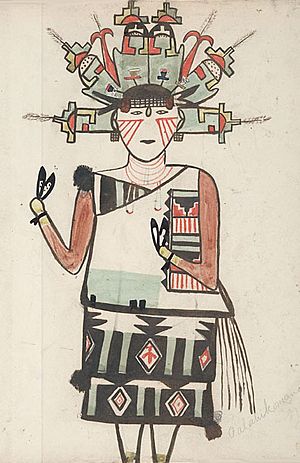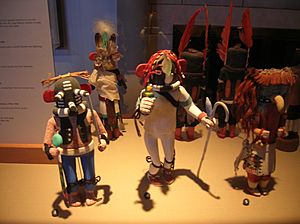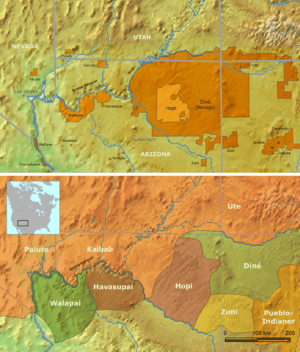Kachina facts for kids
A kachina (pronounced ka-CHEE-na) is a special spirit being. These spirits are important in the religious beliefs of the Pueblo peoples. These are Native American cultures. They live in the southwestern United States. The Hopi, Zuni, and other Pueblo tribes practice kachina rites.
The idea of kachinas has three parts:
- The spirit being itself.
- The kachina dancers, who dress up as the spirits.
- Kachina dolls, which are small carved figures. These dolls are given to people who will care for them. This includes mothers, wives, or sisters.
Contents
What are Kachinas?
Kachinas are spirits or personifications of things. They represent parts of the real world. These spirits are believed to visit Hopi villages. They come during the first half of the year. Each Pueblo community has its own group of kachinas.
A kachina can represent almost anything. This includes a respected ancestor or an element. It can be a place, a quality, or a natural event. There are kachinas for the sun, stars, and thunderstorms. There are also kachinas for wind, corn, and insects.
Kachinas are seen as having human-like relationships. They have uncles, sisters, and grandmothers. They can also marry and have children. People do not worship kachinas. But each kachina is seen as powerful. If treated with respect, they can help humans. They can bring rain, healing, or protection. The main idea of kachina beliefs is that "everything has a life force." Humans must connect with these forces to survive.
Hopi Kachina Spirits
Kachina rites are very important in the Hopi religion. Hopi beliefs say that kachinas live on the San Francisco Peaks. These mountains are near Flagstaff, Arizona. For the Hopis, kachinas are supernatural beings. They visit villages to help with daily life. They also connect gods and people.
According to some experts, kachinas are "the spirits of all things." This includes rocks, stars, animals, and plants. They also include ancestors who lived good lives. Male dancers dress up as these spirits. They wear special costumes and masks. These ceremonies happen during the first half of the year.
The first ceremony is called Powamu. It happens in February. This ceremony is about planting beans. It also marks the start of the growing season. It is also a coming-of-age event. The last kachina ceremony is Niman. It takes place in July. This ceremony is linked to the harvest. After Niman, the kachinas return to the San Francisco Peaks.
Hopi kachina dolls, called tihü, are religious objects. Hopi carvers sometimes change these dolls. They remove their religious meaning. This is to sell them as decorations to non-Hopi people.
Important Hopi Kachinas (Wuya)
The most important Hopi kachinas are called wuya. In Hopi, wuya can mean the spirits themselves. It can also mean the dolls or the dancers. All these parts are connected to the same belief system. Some of the wuya include:
- Ahöla
- Ahöl Maana
- Aholi
- Ahul
- Ahulani
- Akush
- Alosaka
- Angak
- Angwushahai-i
- Angwusnasomtaka
- Eototo
- Hahay-i Wuhti
- He-e-e
- Horo or Yohozro Wuhti
- Hu
- Huruing Wuhti
- Kalavi
- Kaletaka
- Ketowa Visena
- Kötsav
- Kököle
- Kokopelli
- Kokosori
- Kokyang Wuhti
- Koshari or Koyaala
- Kwasai Taka
- Lemowa
- Masau'u
- Mastop
- Maswik
- Mong
- Muyingwa
- Nakiatsop
- Nataska
- Ongtsomo
- Pahlikmana or Polik-mana
- Patsava Hú
- Patung
- Pöqangwhoya
- Pohaha or Pahana
- Saviki
- Shalako Taka
- Shalako Mana
- Söhönasomtaka
- Soyal
- Tanik'tsina
- Tawa
- Tiwenu
- Toho
- Tokoch
- Tsaveyo
- Tsa'kwayna
- Tsimon Maana
- Tsitot
- Tsiwap
- Tsowilawu
- Tukwinong
- Tukwinong Mana
- Tumas
- Tumuala
- Tungwup
- Ursisimu
- We-u-u
- Wiharu
- Wukoqala
- Wupa-ala
- Wupamo
- Wuyak-kuyta
Zuni Kachina Spirits
Religious ceremonies are very important to the Zuni farming society. These ceremonies happen around the winter and summer solstices. They focus on the importance of weather, especially rain. They also help ensure good crops. The Zuni honor Father Sky and Mother Earth. They also welcome the kachinas, who bring many blessings.
The Zuni believe that kachinas live in the Lake of the Dead. This is a mythical lake. It can be reached through Listening Spring Lake. This lake is where the Zuni River and the Little Colorado River meet.
Zuni and Hopi kachinas have differences. But they also share some features. Both are often very detailed. Kachinas from the Rio Grande Pueblos look simpler. The Hopis have developed more elaborate ceremonies. They also show more drama and artistry. The Zuni, however, have more stories about their kachinas.
According to Clara Lee Tanner, "kachina involves three basic concepts." These are:
- First, a supernatural being.
- Second, the masked dancer. When a Zuni wears the mask, he is a kachina.
- Third, the carved, painted, and dressed doll.
The list of Zuni kachinas includes:
- A'Hute
- Ainawua
- Ainshekoko
- Anahoho
- A'thlanna
- Atoshle Otshi
- Awan Pekwin
- Awan Pithlashiwanni
- Awan Tatchu
- Awek Suwa Hanona
- Bitsitsi
- Chakwaina
- Chakwaina Okya
- Chathlashi
- Chilili
- Eshotsi
- Hainawi
- Hehea
- Hehe'a
- Hemokatsiki
- Hemushikiwe
- Hetsululu
- Hilili Kohana
- Hututu
- Ishan Atsan Atshi
- Itetsona
- Itsepasha
- Kakali
- Kalutsi
- Kanatshu
- Kanilona
- Kiaklo
- Kianakwe
- Kianakwe Mosona
- Kokokshi
- Kokothlanna
- Kokwele
- Komokatsiki
- Kothlamana
- Koyemshi
- Kwamumu
- Kwamumu Okya
- Kwelele
- Lapilawe
- Mahedinasha
- Mitotasha
- Mitsinapa
- Mókwala
- Mukikwe
- Mukikw' Okya
- Muluktaka
- Muyapona
- Nahalisho
- Nahalish Awan Mosona
- Nahalish Okya
- Nalashi
- Na'le
- Na'le Okya
- Na'le Otshi
- Natashku
- Natshimomo
- Nawisho
- Neneka
- Nepaiyatemu
- Ohapa
- Oky'enawe (Girls)
- Ololowishkia
- Owiwi
- Paiyatamu
- Pakoko
- Pakok'Okya
- Pasikiapa
- Pautiwa
- Posuki
- Potsikish
- Saiyapa
- Saiyatasha
- Saiyathlia
- Salimopia Itapanahnan'ona
- Salimopia Kohan'ona
- Salimopia Shelow'ona
- Salimopia Shikan'ona
- Salimopia Thlian'ona
- Salimopia Thluptsin'ono
- Sate'tshi E'lashokti
- Shalako (6)
- Shalako Anuthlona
- Shi-tsukia
- Shulawitsi
- Shulawitsi An Tatchu
- Shulawitsi Kohanna
- Shumaikoli
- Siwolo
- Suyuki
- Temtemshi
- Thlelashoktipona
- Thlewekwe
- Thlewekwe Okya
- Tomtsinapa
- Tsathlashi
- Upikaiapona
- Upo'yona
- Wahaha
- Wakashi
- Wamuwe
- Wilatsukwe
- Wilatsukw' Okya
- Wo'latana
- Yamuhakto
- Yeibichai
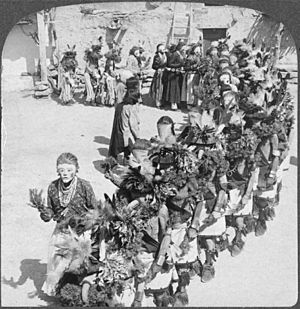
Kachina Dancers
Many Pueblo Indians, especially the Hopi and Zuni, have ceremonies. In these, masked men called kachinas play a big part. Masked tribe members dress up as kachinas. They do this for religious ceremonies. These events happen many times throughout the year.
These ceremonies are also social gatherings. Friends and family come from nearby towns. They watch the dances and enjoy feasts. When a Hopi man puts on a mask and costume, his own identity is gone. The spirit of the kachina he represents takes over. There are also female kachinas called kachin-manas. But women never play the part of male or female kachinas.
Kachina Clowns
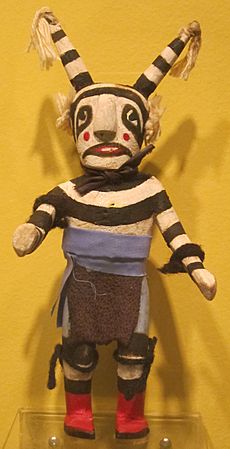
Clown characters have two main roles. Their most obvious role is to entertain the audience. They act as jesters during outdoor celebrations and Kachina Dances. They are like circus clowns. One expert said that clowns show "wrong social behavior." The kachinas then correct them for everyone to see. This makes people more open to learning about good social rules. It also encourages a sense of humor.
The clowns have a more private and sacred role. This role is part of the Hopis' ritual performances. These sacred functions are often kept secret by the Hopi. Because of this, they are less known to the public. One observer was told, "We Koyala [Koshari] are the fathers of all Kachina." This was said while watching clowns prepare for a ceremony.
The Hopi have four groups of clowns. Some of these groups are sacred. It can be hard to identify and classify them. This is because some kachinas also act like clowns. A book called Clowns of the Hopi describes many types of clown characters.
Kachina Dolls
Kachina dolls are small, brightly painted wooden figures. They are miniature versions of the masked dancers. These figures are not given to children as toys. Instead, they are objects to be valued and studied. Young Hopis use them to learn what the kachinas look like. This is part of their religious training.
During Kachina ceremonies, each child gets their own doll. The dolls are then taken home. They are hung on walls or from the ceiling. This way, children can always see them. This helps children learn about the different kachinas. It is said that the Hopi know over 200 kachinas. Many more were created in the late 1800s.
Among the Hopi, maternal uncles traditionally carve kachina dolls. They give them to uninitiated girls. This happens at the Bean Dance (Spring Bean Planting Ceremony) and the Home Dance Ceremony in the summer. These dolls are hard to classify. This is because ideas about them vary. They differ from mesa to mesa and pueblo to pueblo.
Origins of Kachinas
There are two different Hopi stories about where kachinas came from.
One story says that kachinas were kind spirit-beings. They came with the Hopis from the underworld. The kachinas traveled with the Hopis. They wandered until they reached Casa Grande. There, both the Hopis and the kachinas settled. The kachinas had powerful ceremonies. They helped the Hopis a lot, for example, by bringing rain for crops. However, all the kachinas were killed when the Hopis were attacked. Their souls returned to the underworld. The kachinas' sacred items were left behind. So, the Hopis began to act as kachinas. They wore their masks and costumes. They imitated their ceremonies. This was done to bring rain, good crops, and happiness.
Another story says that the Hopis started to take the kachinas for granted. They lost all respect for them. So, the kachinas went back to the underworld. But before they left, the kachinas taught some ceremonies to a few faithful young men. They showed them how to make the masks and costumes. When the other Hopi realized their mistake, they felt bad. They then turned to the human substitutes for the kachinas. The ceremonies have continued ever since.
See also
 In Spanish: Kachina para niños
In Spanish: Kachina para niños


